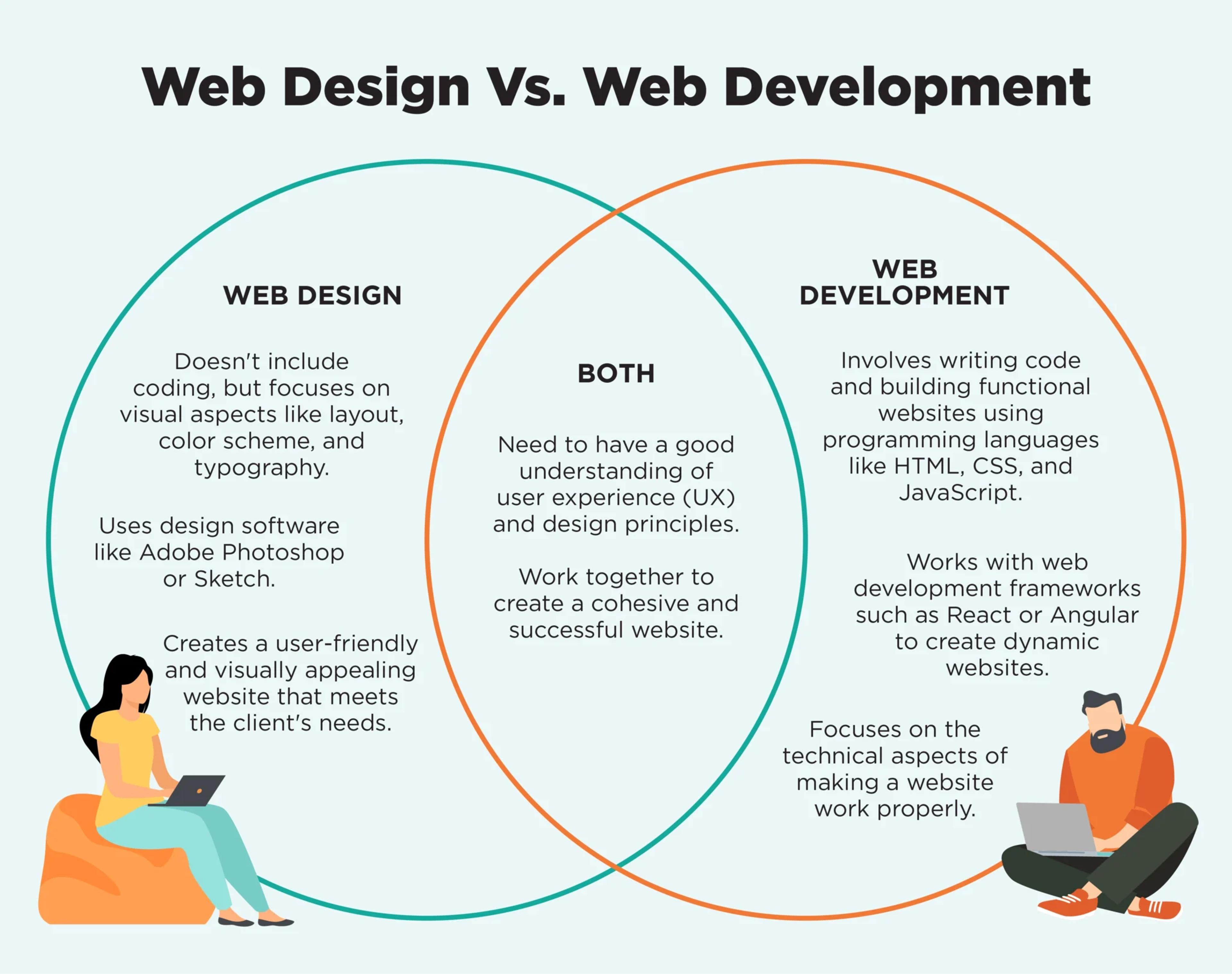The evolution of web design in creating cutting-edge digital experiences
Everything About Website Design: Understanding Its Value for Your Online Presence
Website design offers as an essential aspect of developing an online visibility. It affects individual experiences and forms assumptions of brand names. Efficient website design integrates different components that boost use and engagement. As the digital landscape advances, recognizing the relevance of these layout principles becomes crucial (web development). What are the key elements that make a web site not simply practical, however compelling? Exploring this can disclose important insights for any individual aiming to succeed online
The Role of Website Design in Individual Experience
Website design greatly affects customer experience by forming exactly how site visitors connect with a web site. Aspects such as design, color design, and typography create the very first impact, leading individuals via the content. Effective website design focuses on instinctive navigation, guaranteeing that visitors can quickly locate info without aggravation. Additionally, receptive design boosts ease of access throughout different devices, dealing with a broader target market. The speed of a site also plays a crucial role; slower-loading web pages can cause higher bounce prices and reduced user complete satisfaction. Aesthetic pecking order, attained with spacing and dimension changes, guides customers' focus to key functions or calls to activity. Consistency in style elements cultivates familiarity and count on, urging customers to involve even more deeply. Ultimately, a properly designed site not just draws in site visitors but additionally preserves them, affecting their overall assumption of the brand name or service it stands for. This way, website design is a fundamental component of an effective online visibility.
Key Elements of Effective Website Design
Reliable web design pivots on numerous crucial elements that enhance individual interaction and complete satisfaction. Aesthetic hierarchy principles assist individuals with material, ensuring that crucial details stands out - website design. Mobile responsiveness is necessary in a digital landscape where individuals gain access to websites throughout various devices.
Visual Pecking Order Concepts
Many elements contribute to a successful site, the principles of visual hierarchy stand out as fundamental to leading individual experience. Aesthetic pecking order refers to the setup of style components to connect importance and direct customers' attention properly. Secret factors include size, spacing, shade, and comparison, which help prioritize information and develop a flow that is instinctive for customers. Larger elements commonly draw the eye initially, while contrasting shades can highlight calls to activity. Thoughtful spacing can additionally enhance readability and understanding. By using these concepts, developers can craft a smooth experience that not just involves customers yet additionally helps with navigation and boosts overall use. Eventually, a well-executed visual power structure enhances the web site's effectiveness in sharing its message.
Mobile Responsiveness Fundamentals
Mobile responsiveness is an essential component of contemporary website design, ensuring that sites operate perfectly throughout numerous gadgets and screen sizes. This flexibility improves user experience, as visitors can access material effortlessly whether they use a tablet computer, smart device, or desktop computer . Crucial element of mobile responsiveness consist of fluid grids, flexible pictures, and media questions, which enable layouts to change dynamically. Prioritizing touch-friendly navigation and legible typography better improves functionality on smaller screens. Furthermore, optimizing loading rates is critical, as mobile users typically anticipate fast accessibility to details. By implementing these fundamentals, web developers develop websites that involve users, reduce bounce rates, and ultimately add to increased conversions and client satisfaction. Mobile responsiveness is therefore necessary for preserving a competitive on the internet presence.
The Influence of Website Design on Brand Name Understanding
Website design greatly influences brand perception, beginning with the essential impression a web site makes on site visitors. Constant visual elements improve trust fund and acknowledgment, reinforcing the brand's identification. In addition, a positive individual experience can form exactly how customers involve and check out with the brand in general.
First Perceptions Issue
Their preliminary response can substantially influence their perception of the brand when site visitors come across a web site. A well-designed website can evoke feelings of reliability, trust, and professionalism and trust, while an inadequately created one may trigger uncertainty and question. Individuals often develop judgments within seconds, making the very first perception essential. Aspects such as format, color design, and typography play significant duties in forming these initial thoughts. For instance, a tidy and modern style can communicate technology, whereas obsolete visuals may suggest neglect. Additionally, an user-friendly navigation system enhances individual experience, enhancing favorable assumptions. Efficient web design not only records focus yet additionally develops a strong structure for brand name identification, influencing continuous relationships with visitors and potential clients.
Visual Uniformity Constructs Depend On

User Experience Affects Perception
A natural aesthetic identity lays the foundation for a favorable user experience, which greatly affects brand name assumption. Efficient internet style assurances that customers can browse a site intuitively, resulting in greater fulfillment and interaction. When customers run into a visually pleasing and practical web site, they are most likely to associate the brand name with professionalism and reliability. On the other hand, poor style can lead to aggravation, causing customers to form negative perceptions. Elements such as color design, typography, and format play a crucial function fit psychological responses. Inevitably, a well-designed web site not just enhances usability however additionally strengthens the brand's worths and message, developing a long lasting effect on individual assumption and commitment. Consistency in layout further strengthens this connection, fostering trust and knowledge.
Search Engine Optimization and Web Style
Efficient website design is vital for enhancing search engine optimization (SEO), as it directly affects just how online search engine creep and index a web site. A well-structured website, including intuitive navigating and clear pecking orders, permits internet search engine to conveniently comprehend the content and its relevance. Furthermore, using enhanced meta tags, headings, and alt message for photos better aids in improving visibility in online search engine outcomes.
In addition, web page tons rate, an essential facet of website design, substantially affects search engine optimization rankings. Websites that fill slowly might discourage individuals, resulting in higher bounce rates, which search engines take a negative signal.
Incorporating search engine optimization best techniques right into internet design not just improves search engine positions yet likewise ensures that site visitors have a favorable experience. Ultimately, an all natural technique to website design and search engine optimization can bring about enhanced web traffic, much better individual involvement, and boosted conversion rates, making it crucial for online success.
Receptive Design: Fulfilling Individual Needs Throughout Tools
As users significantly access web sites from a variety of devices, receptive layout has become an essential solution for meeting their requirements. This method ensures that website adjust seamlessly to different screen dimensions, orientations, and resolutions, providing an pop over to this site excellent watching experience. By employing fluid grids, flexible photos, and media inquiries, responsive design allows content to scale and reposition, improving usability across smart devices, desktop computers, and tablet computers.
Responsive design enhances website efficiency, as it usually decreases loading times through enhanced photos and streamlined code. This efficiency not only enhances customer contentment however additionally adds to far better search engine rankings, as search engines prefer mobile-friendly sites. As the digital landscape proceeds to advance, services that prioritize responsive style are much better equipped to engage their audiences successfully, guaranteeing that users can browse and engage with content no matter the gadget they use. Receptive style is essential for maintaining a solid online presence.
The Value of Ease Of Access in Web Design
Internet design not only requires responsiveness to various devices additional reading however likewise requires a commitment to availability for all users. Access in web style assurances that individuals with impairments can navigate, recognize, and connect with online content efficiently. This incorporates different elements, consisting of text readability, alternate text for pictures, and key-board navigating options. By focusing on availability, web developers produce inclusive experiences that satisfy a diverse audience, consequently widening their reach and improving user contentment.
Furthermore, obtainable internet sites can boost seo and decrease prospective lawful dangers related to non-compliance to ease of access criteria. Services that welcome comprehensive style not only accomplish moral responsibilities yet likewise demonstrate social duty, cultivating a favorable brand image. Inevitably, the importance of access in internet style hinges on its capacity to create fair online environments, equipping all users, no matter of their abilities, to involve totally with electronic content and services.
Fads in Website Design: Remaining Present in a Digital World
Staying abreast of trends in website design is vital for developers intending to supply appealing and modern-day user experiences. As modern technology develops, so do user expectations, making it vital for developers to incorporate contemporary components right into their work. Current fads include minimalism, which prioritizes tidy lines and sufficient white area, enhancing use and visual appeal. In addition, the rise of dark mode alternatives accommodates individual comfort while searching.
Receptive layout continues to be vital, making sure websites operate perfectly throughout numerous gadgets. In addition, the integration of micro-interactions includes a layer of interaction, permitting individuals to really feel useful content a link with the website. Using bold typography and dynamic color combinations can likewise aid catch attention in a congested electronic landscape. By accepting these fads, internet developers can develop visually attractive, useful, and user-friendly web sites, inevitably reinforcing their clients' on-line visibility and promoting favorable user interactions.
Regularly Asked Inquiries
Just How Much Does Professional Internet Layout Commonly Price?
Expert website design usually costs in between $2,500 and $10,000, depending on complexity and features. Personalized designs might increase costs even more, while easier themes can lower expenses, making pricing highly variable based upon client requirements.

Can I Style My Web Site Without Coding Expertise?
Yes, an individual can create an internet site without coding knowledge. Various easy to use website home builders and material monitoring systems give design templates and drag-and-drop attributes, making it possible for individuals to produce visually appealing sites quickly and effectively.
What Prevail Errors to Stay Clear Of in Web Design?
Typical errors in website design consist of chaotic designs, poor navigation, lack of mobile optimization, ignoring individual experience, slow loading times, making use of a lot of typefaces or shades, and disregarding access. These mistakes can hinder visitors and decrease interaction.

Exactly how Typically Should I Update My Web site's Layout?
An internet site's layout ought to be updated every two to 3 years, or quicker if significant fads emerge. Routine updates assure relevance, boost user experience, and preserve compatibility with new modern technologies and tools, cultivating continuous engagement.
What Tools Can Assist Me Develop My Own Internet site?
Numerous devices exist for producing websites, consisting of WordPress, Wix, and Squarespace (web development). These systems supply user-friendly user interfaces, personalized layouts, and various features that equip people to design internet sites tailored to their certain needs and choices
Internet design greatly influences user experience by forming exactly how site visitors connect with an internet site. Reliable internet design pivots on several key aspects that enhance individual interaction and satisfaction. Effective internet style warranties that individuals can browse an internet site intuitively, leading to higher fulfillment and engagement. Remaining abreast of trends in internet design is necessary for creators aiming to supply interesting and modern individual experiences. Typical errors in internet design consist of chaotic layouts, inadequate navigating, lack of mobile optimization, neglecting user experience, slow packing times, making use of as well many fonts or shades, and disregarding ease of access.